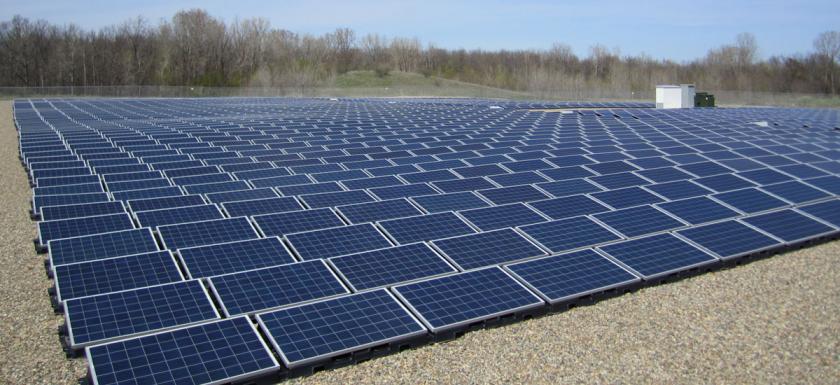Thursday, 18/12/2025 | 03:42 GMT+7
For more than a century, Dawson Singletary’s family has grown tobacco, peanuts and cotton on a 530-acre farm amid the coastal flatlands of North Carolina. Now he’s making money from a different crop: solar panels.
Singletary has leased 34 acres of his Bladen County farm to Strata Solar LLC for a 7-MW array, part of a growing wave of solar deals that are transforming U.S. farmland and boosting income for farmers.
Farmland has become fertile territory for clean energy, as solar and wind developers in North America, Europe and Asia seek more flat, treeless expanses to build. That’s also been a boon for struggling U.S. family farms that must contend with floundering commodity prices.
“There is not a single crop that we could have grown on that land that would generate the income that we get from the solar farm,” said Singletary, 65.
The rise in solar comes as the value of crops in the Southeast — with the exception of tobacco — has dropped. Cotton prices have fallen 71 percent in the last five years. Soybeans are down 33 percent and peanuts have slipped 16 percent.

Solar companies, meanwhile, are paying top dollar, offering annual rents of $300 to $700 an acre, according to the NC Sustainable Energy Association. That’s more than triple the average rent for crop and pasture land in the state, which ranges from $27 to $102 an acre, according to the U.S. Agriculture Department.
The economic incentives spurring solar will be discussed at a Bloomberg New Energy Finance conference in New York starting April 4.
“Solar developers want to find the cheapest land near substations where they can connect,” said Brion Fitzpatrick, director of project development for Inman Solar Inc. of Atlanta. “That’s often farmland.”
Developers have installed solar panels on about 7,000 acres of North Carolina pasture and cropland since 2013, adding almost a gigawatt of generating capacity, according to the NC Sustainable Energy Association. Georgia has added 200 MW on fields and cleared forests over the same period, much of it farmland, according to the Southface Energy Institute of Atlanta.
The number of megawatts developers can generate per acre of farmland varies, based on weather patterns, size of the panels and contours of the land. On Singletary’s farm, Strata Solar installed 21,600 panels, each about 6 feet by 3 feet (1.8 meters by 914 centimeters). Combined, they can power as many as 5,000 local homes.
Long-Term Contracts
Farmers typically lease a portion of their land, signing 15- to 20-year contracts with developers who install the panels and sell the power to local utilities. In rare cases, farmers have leased their entire property to solar companies.
Singletary signed a 15-year lease in 2013, with two 10-year extension options, and Chapel Hill, North Carolina-based Strata sells the power to Duke Energy Corp. He declined to disclose financial terms.
Government incentives have played a key role in the spread of solar farms built on real farms. North Carolina granted developers tax credits equal to 35 percent of their projects’ costs though a program that expired at the end of 2015, helping make the state the third-biggest U.S. solar market. In Georgia, the Public Service Commission passed a bill in 2013 requiring the state’s largest utility, Southern Co.’s Georgia Power, to buy 525 MW of solar by 2016. Both policies sent companies scouring for open space to build.
Solar panels have buoyed tax bases in impoverished rural counties, said Tim Echols, a member of the Georgia Public Service Commission. They also let farmers diversify their income with revenue that’s not subject to markets or unpredictable weather patterns.
‘Stable Income’
“Solar and wind farms have become a new stable income stream for farmers — and they don’t fluctuate with commodity prices,” said Andy Olsen, who promotes clean energy projects in rural areas for the Chicago-based Environmental Law & Policy Center.
Not everyone is happy to see solar panels or wind turbines becoming more common on farmland. In the U.K., lawmakers have pushed to limit large clean energy projects on farms, saying they blight the landscape and squeeze out local food production. Similar criticisms have surfaced in the U.S., where local officials have pushed for zoning changes to restrict solar developments to industrial properties.
Neighbor Complaints
“I get a lot of complaints from neighbors” said Tim Sheppard, who don’t like the looks of the 1-MW solar system that takes up about 5 acres of his 135-acre cattle farm in Brasstown, North Carolina.
Despite the recent flurry of building in North Carolina, solar panels cover less than 1/10th of 1 percent of all farmland in the state, said Maggie Clark, director of government affairs for the NC Sustainable Energy Association.
Singletary, the Bladen County farmer, said the solar panels will let him retire without selling his family land.
“It gives me way to keep the farm,” he said. “I’d like to pass it to my grandchildren someday.”
Renewableenergyworld.com








 Bosch Vietnam Plant Benefits from Investment in Energy Efficiency
Bosch Vietnam Plant Benefits from Investment in Energy Efficiency
 Webinar 2: “Financial Support for Energy Efficiency Enterprises – Opportunities and Challenges”
Webinar 2: “Financial Support for Energy Efficiency Enterprises – Opportunities and Challenges”
 Vietnamese enterprises achieve green growth and cut costs through energy efficiency
Vietnamese enterprises achieve green growth and cut costs through energy efficiency
 Capacity Building for Program Implementing Entity
Capacity Building for Program Implementing Entity
 Promoting Energy Efficiency for Technical Staff of Brick and Ceramic Sector
Promoting Energy Efficiency for Technical Staff of Brick and Ceramic Sector
 Enhance Energy Efficiency Knowledge for Managers of Cement Industrial Enterprises
Enhance Energy Efficiency Knowledge for Managers of Cement Industrial Enterprises
 Capacity building for participating financial institutions of the VSUEE Project
Capacity building for participating financial institutions of the VSUEE Project